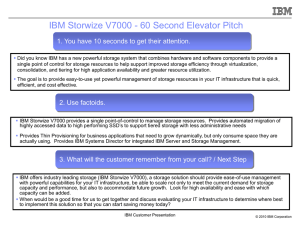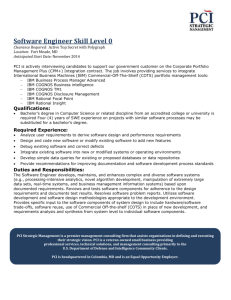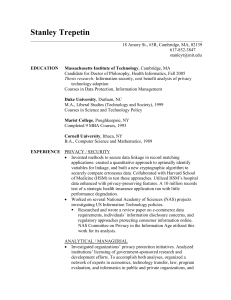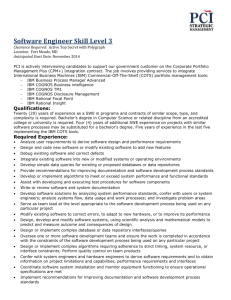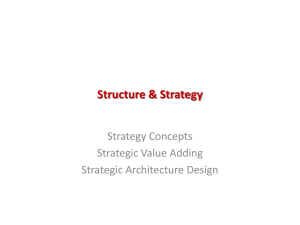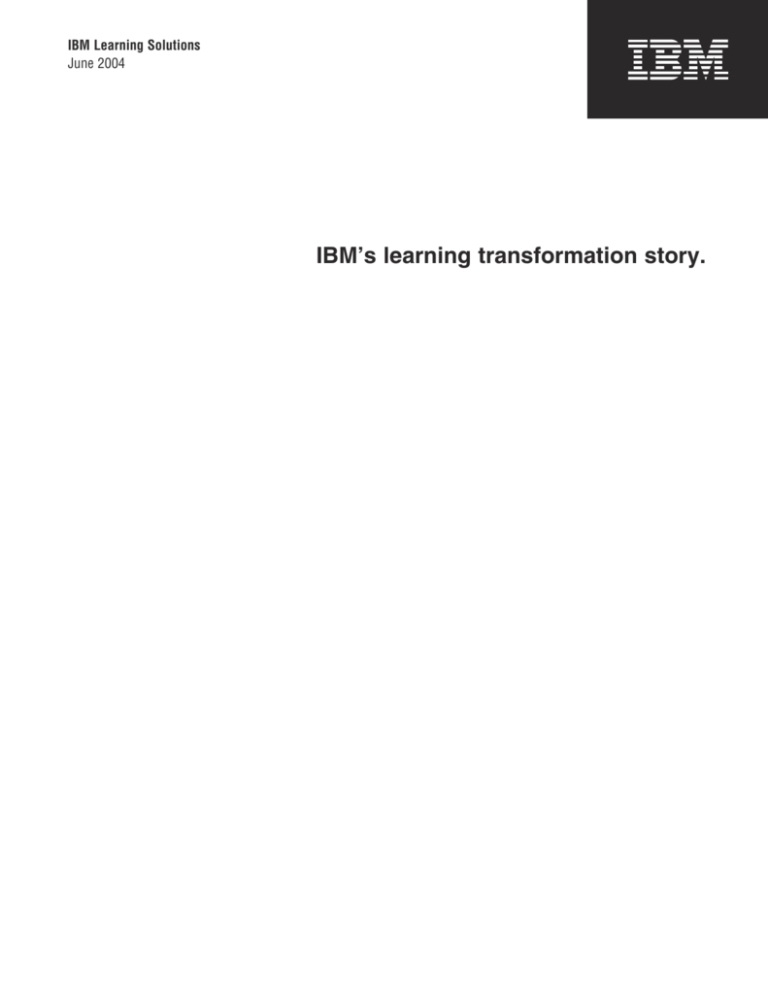
IBM Learning Solutions
June 2004
IBM’s learning transformation story.
IBM’s learning transformation story.
Page 2
Contents
2
Introduction
3
IBM’s vision of learning — an
Introduction
For IBM, learning is a strategic enabler of change — an indispensable tool that
supports new initiatives, re-skills our workforce and prepares us to address
key market shifts and organizational transformations, such as those associated
with the rapidly approaching on demand era.
investment in the future
4
Implementing state-of-the-art
learning at IBM
8
Learning initiatives
17 IBM’s vision for learning
18 Conclusion
The fact that IBM spends about US$750 million annually 1 for learning
initiatives represents a firm commitment to the belief that learning enhances
productivity, enables development of employee potential, empowers employees
and teams to innovate, and extends organizational knowledge to suppliers,
partners and clients.
Through a continual process of learning transformation, IBM has established leadership in learning, as defined and measured by business values,
that is, how learning directly enables IBM’s businesses to win and grow in
the competitive marketplace.
The results are compelling:2
Learning anywhere, anytime and on demand — Employees spend an estimated
17 million hours each year (about 55 hours per employee) in formal training —
either online, through online learning activities or in a traditional classroom.
Approximately 47 percent of IBM learning days are now conducted online
anywhere, anytime.3
Dedicated and talented workforce — IBM studies have linked learning with
employee retention. They have concluded that, when given meaningful learning
and developmental opportunities, 79 percent of IBM employees are likely to stay
with the company for at least three years.4
The bottom line
IBM conducts almost half of all employee training via e-learning, realizing a
cost avoidance of US$579 million over the past two years.5
IBM’s learning transformation story.
Page 3
Highlights
A blended learning approach
The introduction of a blended learning approach has saved US$24 million
annually in deployment costs of IBM’s new-manager training program,
Basic Blue, with five times as much content as delivered by the previous
new-manager program.6
optimizes the return on IBM’s
training investments.
IBM’s Role of the Manager program helped 30,000 managers, leaders and
executives in 70 countries to acquire additional leadership expertise, effectively
lead remote and mobile teams, and create an environment that encourages
continual innovation and creativity.
Over one-third of IBM’s employees use the IBM Signature Selling Method
every day as they develop solutions to client problems. IBM has learned that
the professionals who have trained on and use this method sell two to three
times more than sales personnel who have not. The method is supported by
a portal to allow IBM sales representatives to hone their selling skills and to
help with soft-skills development, such as self-image and rapport-building,
that is necessary for sales success.7
IBM’s vision of learning—an investment in the future
For nearly 90 years, learning has played a key role in enabling IBM’s success.
Based on a coordinated and aligned approach, IBM has fostered and consistently
maintained the highest quality learning programs for employee, managerial and
executive development.
In 1915, only four years after IBM was incorporated, a separate and distinct
IBM education department was established to train and develop employees.
Shortly thereafter, in 1916, IBM’s education program was formally started to
instruct employees on the use of the company’s product line.
Learning started in the early days
of IBM’s history and will continue
into its future.
In 1918 the first formal customer education was offered; in 1921 an IBM
Management Development Program was begun; in 1929 customer training
was instituted. Responding to customer requests, the IBM Customer Education
Program was launched in 1936.
IBM’s learning transformation story.
Page 4
Highlights
Throughout the years, IBM continued to invest in its learning tradition
through a commitment to outreach initiatives and innovation. In the 1990s,
IBM transformed itself from a hardware company to a services-driven organization. This change required rebuilding and re-skilling our employee base.
Learning played a critical role in helping to align employees around new
business models in order to capture business opportunities in the marketplace.
This ongoing commitment to succeed—by harnessing the power of learning
to develop its employees—has enabled IBM to maintain the highest learning
standards in the business world.
Simply put: learning is considered an investment in IBM’s future for our
employees, suppliers, IBM Business Partners and clients.
Implementing state-of-the-art learning at IBM
IBM targets five strategic sectors
to maximize the business
effectiveness of its training.
A focus on face-to-face classroom
learning had become overly costly.
Recently IBM has been focusing on developing core and job-specific competencies and skills. Core competencies are those fundamental behaviors that
every IBM professional needs to achieve. Job-related competencies are those
behaviors required for employees to excel at their jobs. To maximize business effectiveness for job-related competencies, five strategic sectors have
been targeted for significant learning transformation: sales, leadership and
management, employee development, IT training and training to support
business partnerships.
Learning transformation evolved from the recognition that throughout most
of IBM’s history the primary instructional method has been based on timeconsuming, face-to-face interactions. This might involve a week or more of
training per year per employee. Managers told employees what classes to attend.
But as a significant segment of the employee population began to shift from
one opportunity to the next, managers were forced to think about how to more
significantly motivate and engage a valuable workforce. Teaching the workforce
new competencies within limited time schedules became highly problematic.
IBM’s learning transformation story.
Page 5
Highlights
Consequently, the goal became to find a way to deliver information and training, at all levels, in a practical, meaningful and realistic way. And the success
of those programs needed to be measured not simply through learner satisfaction, but by how well this learning would be applied and how effectively this
learning would drive business performance.
Learning governance
Organizations across IBM
business units participate
in learning governance.
Six principles ensure maximum
effectiveness.
IBM’s learning governance model enables the business to pursue the design
and development of the most critical enterprisewide learning priorities. Learning organizations across the business participate in the process of determining
such priorities, and the respective executives are involved to ensure agreement
on the list of enterprisewide priorities to be pursued. This agreement has led
to an official enterprisewide sanction and funding.
IBM’s learning governance model is structured to ensure maximum effectiveness for our learning investment. We use our governance to ensure
adherence to the following principles:
• Align with IBM business so that in every learning intervention IBM strategy
is integrated and implemented
• Manage enterprisewide corporate learning investment, allocation and
spending at a high level
• Exercise a disciplined project approach to enterprisewide learning
• Demonstrate a measurable level of effectiveness and return on IBM’s
learning investment
• Ensure the use of best-of-breed learning methodologies, practices and design
approaches
• Ensure cost-efficiency and effectiveness of learning delivery.
IBM’s learning transformation story.
Page 6
Highlights
The IBM Learning Investment
The IBM Learning Investment Council is made up of representatives from
each business unit to establish the prioritization of projects and funding. They
are also responsible for ensuring that learning is addressing the needs and
requirements of the businesses, including:
Council ensures learning meets
the business units’ requirements.
The Learning Management Council
•
•
•
•
Setting enterprisewide initiative criteria
Determining the enterprisewide priority initiatives
Determining and confirming investment allocation on a project basis
Monitoring progress and spending.
The Learning Management Council was established to help guide the next
phase of IBM’s learning transformation and to provide the guidance and controls necessary to implement the strategic learning plans and portfolio. This
is a separate group from the Learning Investment Council and is composed of
business unit and geography representatives. Learning Management Council
responsibilities include:
guides the next phase of learning
transformation and planning at IBM.
•
•
•
•
•
•
Setting rules on how we manage all of learning in IBM
Defining principles of operation
Defining standards for learning design
Defining vision and strategy for learning systems
Discussing and resolving issues brought forward by learning leadership teams
Exchanging information.
Blending for success
IBM rose to the challenge of a constantly changing business environment by
developing and deploying a blended learning approach. Based, in part, on
the principle that people learn in different ways, this methodology uses four
distinct educational approaches, in conjunction with one another, and enables
members of an organization to grow via an optimal learning experience, and
to become more productive and create value for the company.
The blended learning system
combines Web-based, interactive,
collaborative and face-to-face
learning.
More specifically, the blended learning system combines Web-based, interactive, collaborative and face-to-face learning, and utilizes the best medium
for the level of learning required. It also creates a structure that orchestrates
movement from one learning experience to the next so that each approach
reinforces and builds upon the last.
IBM’s learning transformation story.
Page 7
Highlights
The four blended learning approaches include:
Learning from information — Performance support and reference materials
are frequently used as a starting point. They tend to be Web-based and take
advantage of online information transfer. This allows a person to access only
the materials that are relevant to his or her job function or business needs.
Allowing the learner to move at his or her own pace maximizes interest and
motivation and empowers the user to learn quickly and comprehensively.
Learning from interaction, simulation or games — Typically multimedia-driven,
this type of learning enables a student to focus on practicing with real-life
scenarios, online. Utilizing information learned during the prior approach,
it is self-directed and involves specific modules, interactive games, coaching
and layered simulations. These practice cases provide a multitude of response
choices that help learners master specifically relevant competencies at their
own pace.
Collaborative learning — This approach allows participants to work with peers
in virtual classrooms, e-labs and collaborative sessions to build realtime
awareness with live, online conferences and teaming. It is typically threaded—
meaning there is an expert who posts the scenarios and continually focuses
the discussions.
Classroom-based learning — Face-to-face discussions of lessons learned complement and supplement the three earlier approaches. This approach includes
learning labs, classroom sessions, mentoring, role-playing, coaching, access to
subject matter experts and detailed examination of actual case studies.
IBM’s learning transformation story.
Page 8
Highlights
Learning initiatives
Specific IBM learning initiatives that use the blended learning system originated
from, and are directly aligned with, the emergence or anticipation of business needs. Each of them is constructed to transform and adapt to changing
business environments.
IBM’s employee development transformation
Employee development furthers both
employee and corporate needs.
If employees are able to quickly and effectively satisfy client needs as a
result of their companywide skills enhancement, organizational revenues
will grow. Furthermore, organizations that provide career-expanding incentives for productive staff to remain with the company save human resource
and retraining costs.
Foundational competencies
In 2001, IBM learning began an ambitious two-year effort to define and
implement a core set of competencies that would enable employees to make
effective development choices, maximize their learning time and achieve their
business goals — goals that support the company’s strategy and direction.
A focused development curriculum
helps employees master
fundamental competencies.
Thousands of top-performing IBM employees identified nine core competencies they thought were most critical to top performance, and in December
2003 these fundamental competencies were announced to all employees.
A single, focused development curriculum was provided to help employees
master the competencies, and hundreds of learning solutions were created
or revamped, leveraging a variety of formats.
By placing an emphasis on validated skills, alignment to strategy, personalized
development and consistency of experience, the foundational competencies
have quickly become the cornerstone of people development transformation
within IBM.
IBM’s learning transformation story.
Page 9
Highlights
Blended learning enables success
in an employee’s first year at IBM.
“On-boarding” and assimilation of new employees
Recognizing that providing a smooth “on-boarding” experience is a financially wise, critical foundation for long-term human resource retention and
development, IBM created a new employee learning program called IBM
Connections. The goal of this learning empowerment program is to bring
new hires to class for collaboration and networking, rather than having them
gather for a less-than-engaging lecture. This yearlong learning continuum
provides a blended e-learning program to new employees, in order to maximize employees’ success in their first year.
In the first two to three months, e-learning modules offer basic information
about the organization, help new employees complete administrative tasks
related to working at the company and give insight into the organization and
how it functions. Then a half-day of training explores employees’ past successes and frustrations, and helps them develop strategies and action plans
for success.
A variety of learning activities helps
set skill development in motion.
Other unique components include executive communications, manager/
employee conferences, change-management discussions, follow-up planning
sessions, and on-the-job coaching and mentoring support. These learning
activities help to set employee skill development in motion, cultivate initiative
and harness efforts to the corporate mission.
Individual development planning
It’s not enough to simply train an employee. Crafted individual learning activities designed to focus on an employee’s development ensure company loyalty
and motivate employees toward greater productivity. This is the objective of
IBM’s Individual Development Planning (IDP) program — employees define
career goals and aspirations, including activities that enable them to grow
toward those goals and meet those career opportunities.
IBM’s learning transformation story.
Page 10
Highlights
Employees are better able to reach
their goals through the use of
focused, individual learning activities.
The IDP process begins by focusing employees on their current roles and
responsibilities so they can then determine appropriate learning activities to
achieve their performance objectives. Employees also review corporate and business unit strategies to understand how their roles contribute to those strategies.
Manager-employee discussions may lead to suggested learning activities, such
as Web-based instruction and information, computer-based training, mentoring
with a more experienced employee, shadowing activities to learn about different
roles and business areas, work assignments to apply learning or increase experience, and team-based activities to gain insights from collaboration.
Employees also access a Web-based personal skills assessment tool that gives
them a benchmark of what skills and skill levels they should have for their
current positions and for their future career goals.
Sales transformation
Sales skill transformation is a critical
priority in the on demand era.
In the on demand business world, sales challenges include more than simply
being up-to-date on the latest product advances, new market opportunities
and sales techniques. The challenges of the on demand business world entail
being savvy about innovative ways to build relationships with company leaders—
and to meet client needs with integrated, customized solutions.
For these reasons, IBM has prioritized sales skills transformation as a critical
initiative. It has had a major impact on the quality of IBM services and solutions. This program was based on three objectives:
• Build trusted advisor relationships with key, senior client line-of-business
executives and company leaders
• Improve the industry expertise of our sellers and consultants to effectively
sell and deliver IBM’s integrated industry solutions to our clients
• Address our clients’ problems and concerns with integrated and tailored
industry solutions.
IBM’s learning transformation story.
Page 11
Highlights
C-suite success workshops
are geared toward contacting
In the case of the first objective, IBM developed the C-suite success workshops,
which are geared toward not just contacting but also building relationships
with C-level, client and line-of-business executives. The workshops bring
together senior IBM relationship leaders with three C-level executives from
various industries.
C-level, client and line-of-business
executives and building relationships
with them.
IBM portals enable sales skills
transformation.
To address the second and third objectives, IBM developed workshops to help
the salesforce and technical community gain a better understanding of IBM’s
business solutions, articulate their value to clients and develop a conceptual
design of specific solutions.
A comprehensive e-learning curriculum was made available through the IBM
sales learning portal called sales compass. This environment provides the sales
audience with a vast array of personalized and role-based learning paths — as
well as on demand learning modules on sales methodology, industry insight and
customer business value. In addition, a collaborative sales community portal
provides easy access to experiential industry knowledge and expertise.
The sales compass learning center has become the one-stop shop for pointof-need sales learning — and the learning is presented in the context of specific
challenges that a sales professional might encounter. The IBM Signature Selling
Methodology provides common terminology and process steps — to present the
sales professional with relevant structured learning, tools and knowledge.
Tangible business results demonstrate the value of this blended learning
solution — both in terms of increased productivity and top-line revenue.
Management and leadership development
Basic Blue — new-manager development
Basic Blue was IBM’s first blended
learning initiative.
In 1999, IBM launched Basic Blue for Managers. It has been used as the core
training program for new managers worldwide and is a comprehensive, enterprisewide example of IBM’s first blended learning initiative. It has had a profound
impact throughout the IBM corporation and throughout the learning industry.
Several fundamental learning models and practices launched as part of this
initiative have been leveraged for other programs in IBM.
IBM’s learning transformation story.
Page 12
Highlights
The Basic Blue program helps new managers build skills that are necessary to
promote change, align behavior with new corporate strategies, reduce bureaucracy,
emphasize customer focus and inspire the highest employee performance.
Basic Blue is a three-phase approach to management and leadership development. This learning solution for new IBM managers offers the optimum blend
of learning methods through its three phases:
Basic Blue employs three phases
for management and leadership
development.
Phase I — The purpose of Phase I is to immediately bring critical management/
leadership information to the new IBM manager via a combination of e-learning,
simulations, in-field experiences and second-line coaching.
Phase II — In this phase, employees increase management and leadership skills
and build upon the knowledge gained in Phase I through a five-day, face-toface, experience-based workshop.
Phase III — Employees continue via e-learning and on-the-job training, similar to Phase I, to apply concepts that have been learned. Participants have the
opportunity to collaborate with peer managers while practicing and reinforcing
skills by applying them on the job.
Since its inception, Basic Blue has won numerous industry awards and has had
a profound impact on learning at IBM. For example:
A blended learning approach has
helped the Basic Blue program
achieve demonstrable success.
• Studies conducted by Harvard Business School and other organizations
determined that Basic Blue enables managers to learn five times as much
material at one-third of the cost of a classroom-only approach.8
• Based on 5,000 new managers per year and a program cost of US$5 million,
a cost avoidance of US$88 million has been achieved since the program was
launched in 1999 (includes all program costs, travel, living expenses and
manager time).
IBM’s learning transformation story.
Page 13
Highlights
This learning initiative addresses
management’s role from an
on demand perspective.
Role of the manager at IBM — management development transformation
Managers need to be able to look for ways to develop their full potential so
that their best employees constantly have the opportunity to grow and make
a difference in the business. This means building basic behaviors, such as
remaining connected with peer managers within their business unit to share
solutions and building networks, as well as defining and executing actions that
create business results. This is why IBM developed a learning program that
addresses the management role from an on demand perspective. To date, this
two-year initiative has been the largest transformational management development initiative in the history of IBM. It touches 30,000 executives, leaders
and managers at IBM across all business units and geographies.
In less than a year, the Role of the Manager at IBM program has:9
• Served as a catalyst for IBM’s managers to create and sustain new momentum to achieve and exceed revenue goals for the year
• Helped produce a net return of more than US$20 million in less than one
year in just one of nine IBM business units
• Improved manager effectiveness, to drive increased employee engagement
and morale, increase achievement of IBM’s strategic objectives and increase
collaboration and communication among brands and teams.
Managers identify and address
pressing issues by business unit
and then formulate action plans
with targeted strategies and goals.
The Role of the Manager at IBM is a companywide, blended learning program
designed to focus managers on identifying and addressing pressing business
issues by business unit — and then to formulate action plans with targeted
strategies and goals. It leverages e-learning, in-person learning, management
communities and the full capabilities of the IBM intranet. It has enterprisewide elements, as well as elements customized to each business group, and
operates in five phases:
Phase I: Customized requirements by business unit — Each business unit is
exposed to customized requirements based on industry and location. Online
labs, each with its own unique actions, facilitate the process of learning.
IBM’s learning transformation story.
Page 14
Highlights
There are five phases in the Role
of the Manager program.
Phase II: ManagerJam — New technology and learning methods are used to
gather input on key leadership issues and allow key executives to dialogue or
jam with each other online. The discussion is focused and directed, and develops a team approach to resolving issues defined by the unit.
Phase III: Edvisor — This is a Web-based, online tool developed to support
continuous learning for all managers, including those in nontraditional office
situations, and remote and mobile workers. Edvisor has three components:
exploring Web-based learning, preparing for the role of manager and formulating an individual development plan.
Phase IV: The in-class learning lab — This phase comprises two days that
focus on experiential, higher-order learning, personal networking and
action learning.
Phase V: Manager ongoing dialogue — An online, shared e-space provides a
means for the same group of managers to collaborate on their chosen management action challenges.
IBM technical training
In 2003, IDC ranked IBM as the world’s largest IT training provider. IBM
develops comprehensive, flexible portfolios of technical training and education services designed to enable its IT professionals to acquire, maintain and
optimize mission-critical IT skills.
Roadmaps for technical training
encompass many key elements.
IBM technical employees, as well as technical employees from our clients,
partners and suppliers, can plan their skills development or certification via
technical roadmaps. These roadmaps include opportunities for classroom and
blended learning. For example, a roadmap may include the following elements:
•
•
•
•
•
•
•
Online courses (some with online labs)
Reference books or certification preparation guides
Online pretests
Self-paced virtual classes
Mentoring
Boot camps (including self-paced, pre-study and certification exams)
Advanced classroom-based, instructor-led offerings.
IBM’s learning transformation story.
Page 15
Highlights
Through the IBM Global Campus, an internal learning portal, employees can
search the worldwide IBM course catalog, enroll in e-learning or classroom
courses, and start e-learning courses.
IBM continuously invests to upgrade the technical skills and expertise of its
employees. In hot skill areas alone — including Linux, wireless and business
integration — IBM is targeting US$200 million to build the expertise of more
than 100,000 employees in 2004.10
IBM intranet
The IBM intranet home page
provides customized information
to employees.
IBM’s intranet is the primary vehicle for providing business-critical information to employees. With an average of 2.4 million pages viewed per business
day, it has become the number-one trusted source for employee information.
In addition to providing up-to-the-minute organizational and industry news,
the intranet home page provides customized information to employees based
on their job roles, responsibilities and areas of interest.
There are processes that alert the IBM staff to shifts in the industry and customer requirements and processes that educate and communicate changes, as
well as information to address new requirements and shifts. IBM has extensive
online networks where experts share insights and best practices in realtime,
allowing a broadening of the scope of response, but also enabling efficient
responsiveness. Announcements can be rolled out across the organization
immediately, and a training module can be developed within an hour.
Collaborative teaming solutions
provide the ability to share
business-critical information to
groups of IBM employees who are
working on a common project.
IBM’s collaborative teaming solutions provide the ability to share business-critical
information to groups of IBM employees who are working on a common project.
Many of the largest account teams that support the leading global clients operate in a virtual collaborative space. This ensures that all IBM employees, no
matter where they are in the world, have accurate and timely information that
they use to work together virtually and to respond to critical customer issues.
IBM’s learning transformation story.
Page 16
Highlights
And as the culture of learning is transformed, IBM is dedicated to continually
expanding and overhauling its existing programs. Establishing new models
based on our learning experiences in the field enables IBM’s business leaders
to better serve their clients by sharing those experiences and helping their
clients maximize their growth potential.
IBM PartnerWorld initiative
IBM offers training roadmaps to
90,000 IBM Business Partners.
In February 2003, IBM renewed its long-standing commitment to facilitating
the success of IBM Business Partners by announcing a new initiative designed
to enable its network of 90,000 Partners to deliver e-business on demand™
solutions to clients of all sizes.
To enable the success of its Business Partners, IBM launched a training and
certification initiative to help Business Partners develop individual and/or
companywide skill plans to support their business strategies. Partners can
develop and use skill profiles to assess their companies’ skills and then use the
skill roadmaps to develop individual skill plans. Competency roadmaps were
developed for these five areas:
•
•
•
•
•
IBM PartnerWorld University is
designed to enhance Business
Partners’ e-business knowledge.
Marketing
Sales
Solution design
Application development
Business management.
To support this effort, IBM launched PartnerWorld® University as one of IBM’s
key skill-building offerings designed to enhance Business Partners’ knowledge of e-business and to help them better leverage their participation in IBM
PartnerWorld activities. This no-cost, online education resource provides easy
access to a wide variety of lectures—available around the clock. Courses are
delivered using the Web-lecture format with slide show and audio technology.
Lectures can be viewed online or downloaded for later viewing.
IBM’s learning transformation story.
Page 17
Highlights
IBM’s learning strategy is designed
to meet the needs of the future.
IBM’s vision for learning
Learning that supports the ongoing transformation process is a core vision
at IBM — even more crucial in today’s business environment. IBM’s goal is to
create an environment where it is easy for employees to learn what they need,
when they need it, and to apply their knowledge, understanding and experience for their own benefit as well as IBM’s. To achieve this objective, IBM’s
learning strategy is to:
• Invest in strategic learning initiatives that have the highest impact on business results as measured by business results and personal outcomes
• Leverage the intellectual capital of IBM employees, through collaboration,
to grow the knowledge base
• Advance learning design to provide effective and robust learning experiences that speed the transfer of knowledge to employees, Business Partners
and clients to solve business problems faster
• Enable pervasive learning systems to ensure that learning solutions reach the
target audience and meet their needs in order to achieve the desired results.
will require just-in-time learning.
But to respond to the business world of the future — one that’s in flux due to a
complex convergence of rapidly changing markets, emerging technologies and
new workforce demographics — companies will need to accelerate their transformation and be more innovative than the competition on an ongoing basis.
They’ll need to respond to a world where information, solutions and results
are on demand. They’ll require the ability to access just enough information
and just the right information, just in time for particular needs.
The learning archetype for the
While traditional teaching avenues (classrooms, lectures and manuals)
continue to provide value for individual, team and organizational learning, the marketplace continues to evolve very rapidly. The need to quickly
address the changing requirements of clients and the enterprise requires a
different approach. As these transformational and innovative business needs
The business world of the future
on demand business environment
must be rethought and reinvented.
IBM’s learning transformation story.
Page 18
Highlights
are increasingly driven by an on demand age, learning can no longer remain
focused solely on individual productivity. The learning archetype for the on
demand business environment must be rethought and reinvented:
• Learners must be empowered to shape, rather than just passively receive,
their learning experiences
• Opportunities to learn must become embedded in process workflows,
enabling learning while doing
• The focus of learning must extend beyond learners as individuals to include
learners as teams and organizations
• Learning must become a key vehicle to enhance relationships across the
enterprise and its entire value chain.
Conclusion
Today’s business world cannot operate on yesterday’s models.
To ensure competitive advantage,
maximize revenues and minimize
risk, companies must provide and
embrace innovative learning.
IBM is allocating approximately
US$750 million annually to develop
and institute the highest level
of learning capabilities for all of
its employees.
Meeting the enormous demands of a fast-changing, 21st-century marketplace
requires the ability to rapidly access relevant resources and leverage advanced
skills to address new market opportunities and deliver customized solutions to
clients — all with the speed of a keystroke. To ensure the highest level of competitive advantage, maximize revenues and minimize risk, companies must
provide and embrace — across the entire organization — the kind of innovative
learning that will facilitate meeting these powerful challenges.
Embracing these business fundamentals, IBM is allocating approximately
US$750 million annually to develop and institute the highest level of learning capabilities for all its employees—from new employees to executives, from
electrical engineers and software programmers to sales professionals. As part
of its ongoing legacy of transformational learning, new program archetypes
that target these on demand business requirements are not only being created
and implemented, but are already yielding significant, bottom-line results for
both IBM and its Business Partners.
But this is just the beginning.
IBM’s learning transformation story.
Page 19
Highlights
The next step for IBM is the
implementation of an employee
portal environment—an on
demand workplace for its
320,000 employees.
In an increasingly on demand business environment, learning will continue to
be a critical enabler of change at IBM. The focus on growth and innovation for
our business will require an ongoing alignment of our learning initiatives to
business priorities. It will also require that we implement cutting-edge design
and delivery approaches along with the application of new technologies to
learning, so that we can enhance the productivity of our increasingly mobile
and flexible workforce. And it will require that we orchestrate the change
through a governance model that ensures consistency when needed, while
providing appropriate levels of autonomy.
The next step for IBM is the implementation of an on demand workplace for
its 320,000 employees. This employee portal environment will integrate mainstream applications with relevant learning for key client-facing roles. This will
enable IBM employees to learn more seamlessly while working. It will also
require a culture that continues to promote ways for our employees to be both
consumers and creators of learning and knowledge, enhancing the learning
culture that drives organizational performance.
For IBM, learning is embedded in our DNA. It is essential to IBM’s success
today and into the future. IBM will continue to invest in effective learning
programs that deliver business value, while at the same time driving innovations in learning to advance the learning industry.
For more information
For more information about IBM Global Services, contact your IBM sales
representative or visit:
ibm.com /services
© Copyright IBM Corporation 2004
IBM Global Services
Route 100
Somers, NY 10589
U.S.A.
Produced in the United States of America
06-04
All Rights Reserved
The e-business logo, e-business on demand, IBM,
the IBM logo and PartnerWorld are trademarks of
International Business Machines Corporation in
the United States, other countries, or both.
Other company, product and service names may
be trademarks or service marks of others.
References in this publication to IBM products
or services do not imply that IBM intends to
make them available in all countries in which
IBM operates.
1, 3, 4, 5, 6, 10
IBM internal research.
2
Sosbe, Tim, “Ted Hoff: Leading IBM’s Education
Solutions,” www.clomedia.com, (Chief Learning
Officer), January 2003, p. 3.
7
Ramos, Laura and Claire Schooley, “New models
for portals and e-learning integration deliver value,”
GIGA, January 29, 2004.
8
Mullich, Joe, “A Second Act for E-Learning,
” Workforce, February 2004, pp. 51 – 55.
9
Sosbe, Tim, “Ted Hoff: Leading IBM’s Education
Solutions,” www.clomedia.com, (Chief Learning
Officer), January 2003, p. 1.
G510-3867-00



